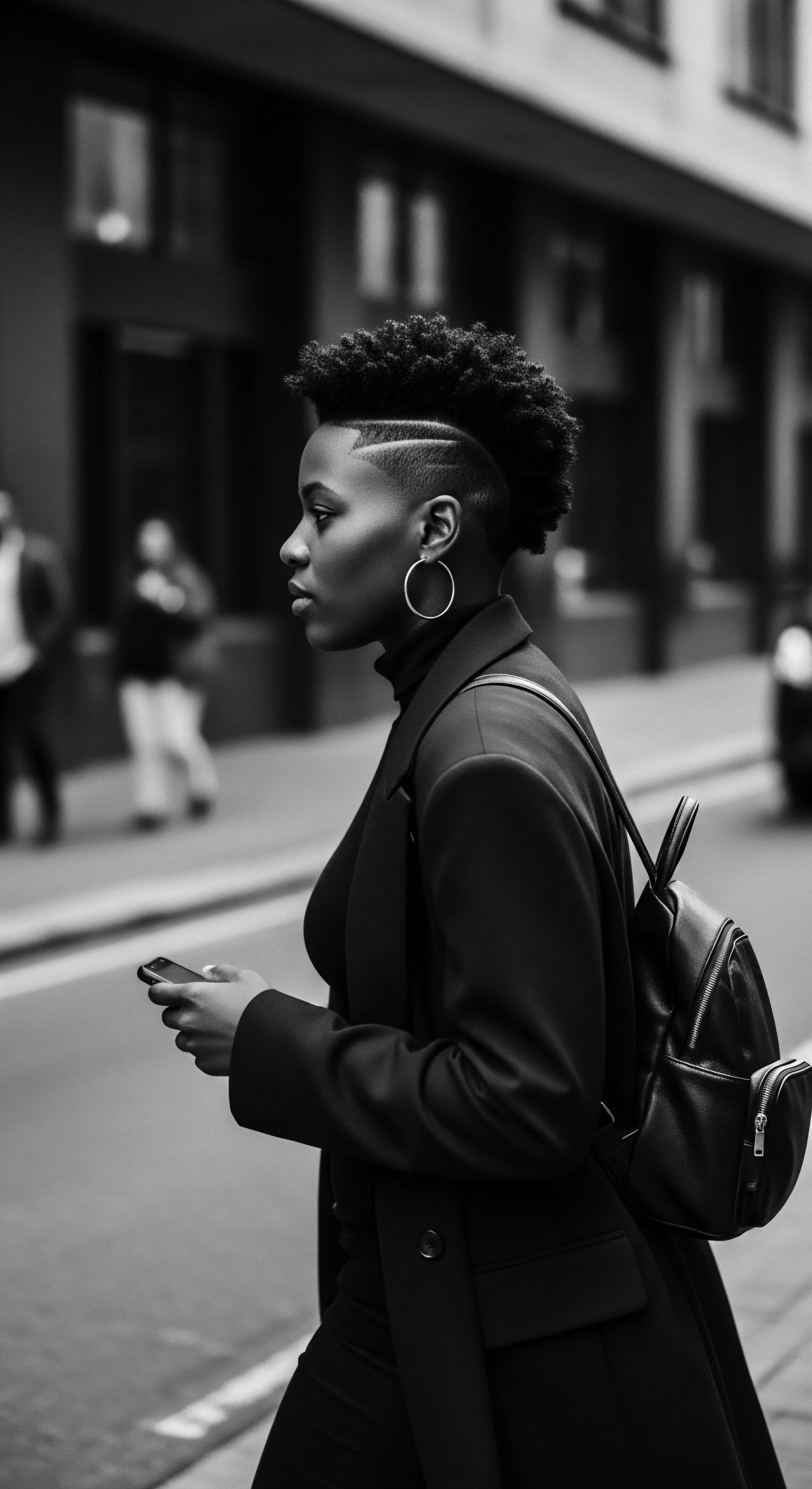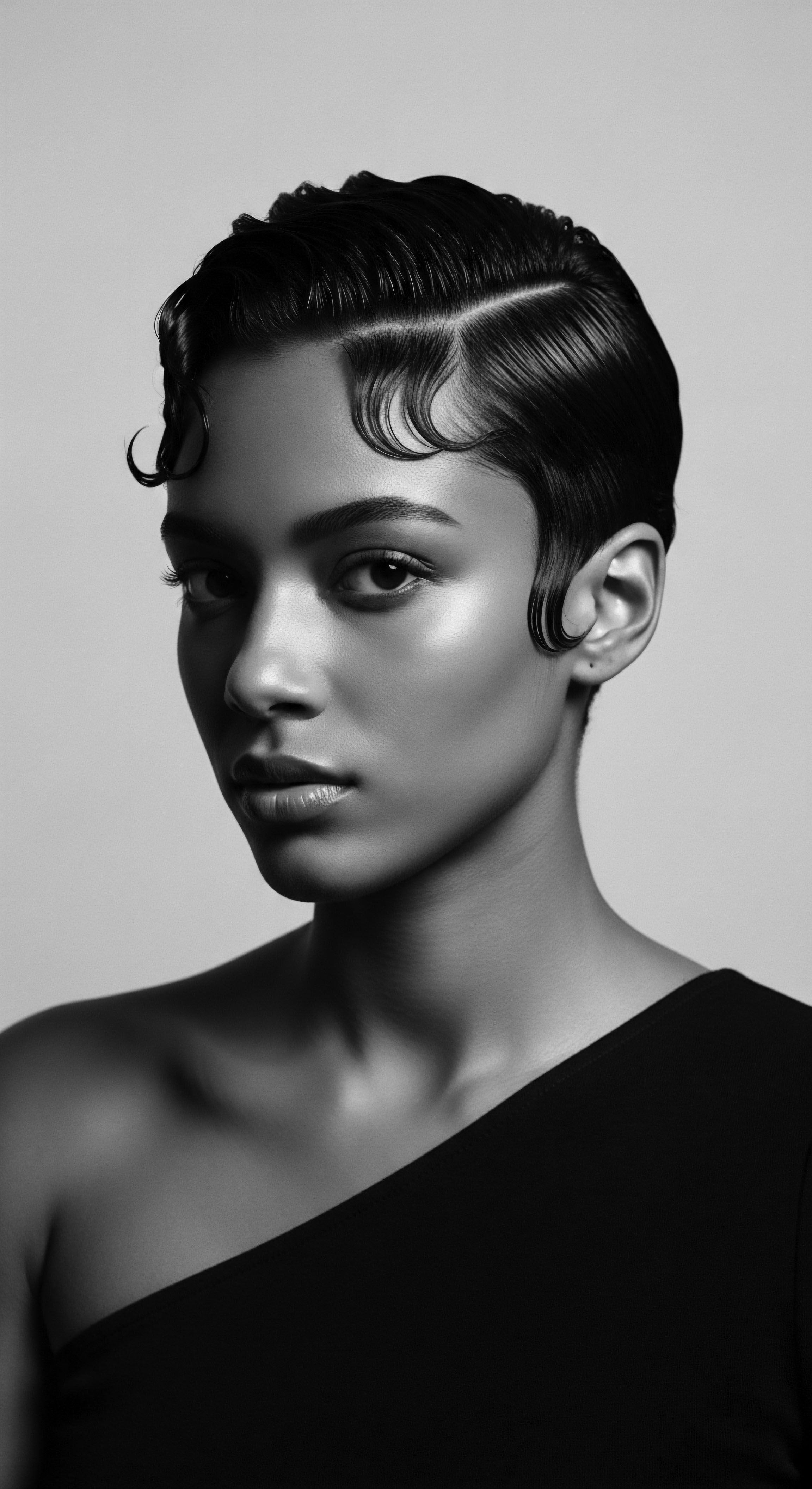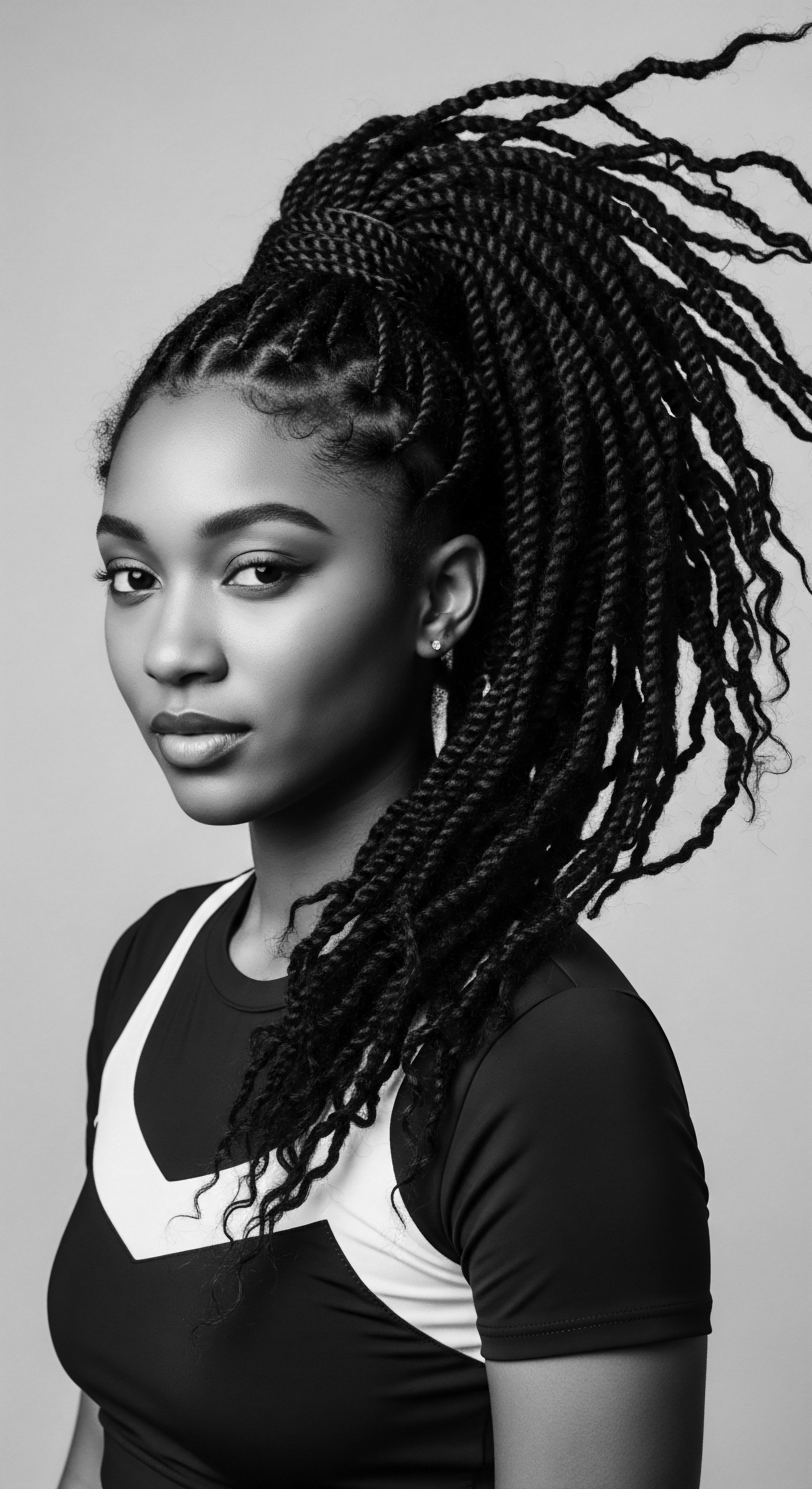
Fundamentals
The High-Top Fade, in its elemental meaning, refers to a specific sculpted haircut characterized by a significant height of hair atop the head, gradually shortening as it descends towards the nape and sides. This gradual shortening creates a gradient, a seamless transition from fullness to closely cropped strands. This particular style, while seemingly simple in its description, carries a profound weight of cultural meaning, particularly within the heritage of textured hair. Its physical attributes – the towering crown and the meticulously shorn sides – speak to both an appreciation for gravity-defying volume and a commitment to precision.
At its core, this haircut represents an interplay between natural hair properties and skilled artistry. The uppermost section of the hair retains its natural length, often shaped into geometric forms, cylinders, or even more abstract designs. The sides and back, by contrast, are expertly tapered, becoming progressively shorter until they vanish into the skin, hence the term “fade.” This technique demands exceptional proficiency from the barber, a deep understanding of hair texture, and the nuanced behavior of coils and curls.
The High-Top Fade, a sculpted haircut with height on top and tapering sides, represents a potent fusion of natural hair elevation and precise barbering artistry.
For those encountering it for the first time, the High-Top Fade’s distinct silhouette often sparks curiosity. It stands as a visual proclamation, a statement of deliberate styling and control over one’s natural hair. Its very existence acknowledges the unique possibilities presented by kinky and coily hair, showcasing how these textures can be molded and elevated beyond conventional expectations. The inherent structure of textured hair allows for this architectural feat, as its coils possess the innate ability to stand upright, holding shape and volume with a resilience unparalleled by straighter hair types.
The foundational aspects of this haircut are not merely cosmetic. They extend into the realm of self-expression and identity. The clarity of its lines and the boldness of its vertical presence distinguish it as a style that commands attention, making it a visible marker of individual choice. The care involved in maintaining such a precise cut also hints at a deeper commitment to personal presentation, a ritual of upkeep that links the individual to a broader cultural practice.

Intermediate
Moving beyond its fundamental description, the High-Top Fade stands as a significant cultural signifier, deeply interwoven with the experiences of Black and mixed-race communities. It gained widespread visibility in the late 20th century, emerging as a powerful symbol during a period of intense cultural creativity and societal shifts. This style was far from an arbitrary fashion choice; it emerged from a rich lineage of hair expression, drawing from ancestral traditions while simultaneously forging a contemporary identity.
The style’s widespread acceptance, particularly in the 1980s and early 1990s, paralleled the ascent of hip-hop culture. Here, the High-Top Fade became synonymous with a fresh, defiant aesthetic, reflecting a generation’s desire to express individuality and collective pride. It was a visual anthem, proclaiming presence and creativity in public spaces. The height of the fade often mirrored the aspirations of the wearers, a literal elevation of self within a society that too often sought to diminish Black existence.
The crafting of a High-Top Fade requires a nuanced understanding of textured hair’s natural properties. The ability of coily and kinky hair to defy gravity, to hold shape without extensive chemical intervention, is central to this style’s existence. Ancestral hair practices, passed down through generations, often focused on manipulating natural texture to create protective styles or symbolic adornments. The High-Top Fade, in its modern iteration, carries echoes of this ingenuity, transforming raw texture into a deliberate, architectural statement.
The High-Top Fade, prominent in the late 20th century, became a cultural touchstone for Black and mixed-race communities, expressing identity and pride through its unique sculpted form.
Consider the technical artistry involved ❉ the gradient of the fade, meticulously carved into the hair, speaks to a heritage of precision in grooming. Barbers, often communal figures, wielded clippers with an almost sculptural sensibility, understanding the unique growth patterns and curl memory of each individual’s hair. This expertise, honed over years, represents a practical application of ancestral knowledge about textured hair, translated into a contemporary art form.
- Density ❉ The inherent density of textured hair types allows for the compact, upright structure necessary for the ‘high’ aspect of the fade.
- Curl Memory ❉ Coils and kinks possess a natural ‘memory,’ meaning they retain the shape they are given, which is essential for maintaining the clean lines and overall form of the High-Top Fade.
- Scalp Health ❉ The close-cropped sides of the fade often necessitated attention to scalp health, a practice deeply rooted in ancestral care rituals that prioritized cleanliness and nourishment of the hair’s foundation.
Beyond the visual, the High-Top Fade served as a tactile connection to self. The sensation of the closely shorn sides against the skin, contrasting with the soft, voluminous crown, provided a unique sensory experience. This physical connection to one’s hair, in a style that so boldly celebrated natural texture, fostered a sense of acceptance and self-affirmation. It provided a stark contrast to historical pressures that often encouraged the alteration of natural hair through chemical straightening or concealment.

Academic
The High-Top Fade transcends a fleeting fashion trend; it operates as a profound cultural artifact, a visible manifestation of identity, resistance, and aesthetic autonomy within the African diaspora. Its precise delineation and volumetric ascension offer a compelling case study in the semiotics of hair, illustrating how individual grooming practices coalesce into powerful collective expressions. To truly comprehend the High-Top Fade requires a multi-layered inquiry, moving from the biomechanical properties of textured hair to its intricate sociological and historical positioning.
From a biological standpoint, the High-Top Fade’s distinct structure relies fundamentally on the unique helical morphology of melanin-rich hair strands. Unlike European or Asian hair, which tends to grow downward due to its elliptical or round cross-section, coily and kinky hair possesses an ellipsoid shape, causing it to grow in tight, spring-like formations. This inherent structural characteristic provides the natural elasticity and spring-like memory essential for defying gravity and sustaining the sculpted height of the top section.
The ability of these tight coils to interlock and support each other creates a robust, self-supporting mass that can be carved into geometric perfection, a direct biological precondition for the style’s existence. This stands as a testament to the hair’s inherent capabilities, a resource waiting for creative expression.
Historically, the High-Top Fade emerged as a successor to the Afro, itself a potent symbol of Black pride and self-acceptance in the 1960s and 70s. However, the fade offered a more refined, precise alternative, reflecting a new cultural moment. It resonated deeply with the burgeoning hip-hop movement of the late 1980s and early 1990s, where its clean lines and bold silhouette provided a visual parallel to the sharp lyrical precision and confident swagger of the genre. Scholar Kobena Mercer, in his seminal work on Black hair politics, extensively discusses the performative aspects of African diasporic hair, noting how styles often serve as “visual acts of self-definition” (Mercer, 1994, p.
110). The High-Top Fade, with its architectural exactness, became a prime example of this deliberate self-definition, a way for Black youth to present themselves as disciplined, creative, and empowered, often directly challenging caricatures propagated by mainstream media.
The High-Top Fade, a sculptural manifestation, highlights the unique biomechanical properties of melanin-rich hair, enabling its gravity-defying volume and intricate shaping.
The adoption of the High-Top Fade also holds economic and social implications. The maintenance of this style necessitates regular visits to skilled barbers, often Black-owned establishments, reinforcing community bonds and economic circulation within these spaces. These barber shops have historically served as crucial social hubs, informal community centers where ideas were exchanged, news disseminated, and collective identity reinforced. The High-Top Fade, by requiring such consistent, expert care, therefore solidified the role of the barber as a cultural artisan and communal anchor.
A study conducted by Byrd and Tharps (2001) in their examination of Black hair culture, for example, points to the barber shop as a consistent site of Black male sociality and cultural exchange, a phenomenon strongly influenced by the rise of intricate, high-maintenance styles like the fade which demanded frequent professional intervention. This highlights not just an aesthetic preference, but a sustained cultural economy built around self-presentation.
| Historical Period / Practice Ancient African Geometric Hair Art |
| Description / Connection to High-Top Fade Many pre-colonial African societies utilized intricate hair designs, often involving precise braiding, sculpting, and shaving patterns. These historical practices demonstrate a long-standing tradition of using hair as a medium for artistic expression, social status, and identity, laying conceptual groundwork for styles valuing clear lines and form like the High-Top Fade. |
| Historical Period / Practice The Afro (1960s-1970s) |
| Description / Connection to High-Top Fade A powerful symbol of Black liberation and natural beauty, the Afro emphasized volume and unadulterated texture. The High-Top Fade can be seen as a natural evolution, retaining the pride in volume but introducing greater structure and formal precision, a more 'architectural' interpretation of natural hair. |
| Historical Period / Practice Hip-Hop Era (Late 1980s-Early 1990s) |
| Description / Connection to High-Top Fade The High-Top Fade became the quintessential haircut of this period, deeply tied to music, fashion, and an assertive youth culture. Its sharp lines and bold height mirrored the genre's confidence and innovative spirit, becoming a visual emblem of the era. |
| Historical Period / Practice Contemporary Adaptations |
| Description / Connection to High-Top Fade Modern iterations of the fade continue to play with varying heights, textures, and added designs, reflecting an ongoing dialogue between historical reverence and contemporary personal expression, often incorporating subtle nods to ancestral patterns through carved lines. |
| Historical Period / Practice The enduring legacy of Black hair styling, from ancient forms to the High-Top Fade, showcases a continuous lineage of creativity and self-expression through textured hair. |
Moreover, the High-Top Fade served as a statement against assimilationist pressures. In a society that historically pathologized Black hair, advocating for its straightening or conforming to Eurocentric beauty standards, the High-Top Fade proudly elevated and celebrated the natural orientation of kinky and coily hair. It was a conscious choice to manipulate, but not fundamentally alter, the hair’s inherent structure.
This act of styling, rather than conforming, spoke volumes about self-acceptance and a reclamation of aesthetic agency. Its architectural presence created a visual metaphor for the strength and resilience of Black communities.
The psychological resonance of the High-Top Fade is also noteworthy. For many Black men and boys, the style provided a sense of sharp confidence and self-assurance. The meticulous care required for its upkeep instilled a discipline, a daily ritual that reinforced personal agency. This ritualistic engagement with one’s hair can be understood as a modern echo of ancestral grooming practices, where hair care was often communal, therapeutic, and deeply spiritual.
The clean, defined perimeter of the fade creates a powerful frame for the face, drawing attention to individual features and projecting an image of clarity and determination. This goes beyond superficial aesthetics; it speaks to the intimate relationship between self-presentation and self-perception, particularly when one’s natural features have historically been devalued.
- Cultural Validation ❉ The widespread popularity of the High-Top Fade across diverse socio-economic strata in the Black community solidified its position as a culturally validated aesthetic, offering a sense of belonging and shared identity.
- Economic Impact ❉ The demand for skilled barbers proficient in fades created significant economic opportunities within Black communities, reinforcing local businesses and specialized expertise.
- Aesthetic Innovation ❉ The High-Top Fade spurred innovations in barbering tools and techniques, pushing the boundaries of precision cutting and blending for textured hair.
- Youth Empowerment ❉ For young Black individuals, the High-Top Fade offered a tangible way to express their identity and connection to hip-hop culture, fostering confidence and group cohesion.
In conclusion, the academic meaning of the High-Top Fade extends far beyond its physical parameters. It serves as a living archive of cultural evolution, a testament to the biological wonders of textured hair, and a potent symbol of identity, resilience, and community within the African diaspora. Its study illuminates not only a haircut but also the enduring legacy of hair as a profound medium for human expression and societal negotiation. The style continues to be reinterpreted and re-imagined, a dynamic symbol that carries its rich heritage forward into contemporary forms.

Reflection on the Heritage of High-Top Fade
The High-Top Fade, in its sculpted magnificence, stands as a testament to the enduring creativity and resilience embedded within textured hair heritage. It is more than a momentary style; it is a resonant echo from the source, a vibrant thread in the grand tapestry of Black and mixed-race hair experiences. From the intricate adornments of ancient African civilizations to the bold statements of self in contemporary times, hair has always been a language, a chronicle etched onto the very crown of our being. The High-Top Fade speaks volumes in this ancient tongue, articulating confidence, cultural pride, and a keen eye for architectural beauty.
This particular style, with its deliberate height and meticulous fade, reminds us of the inherent power of our coils and curls. It showcases their unique ability to defy gravity, to form structures that are both aesthetically compelling and deeply meaningful. The very existence of such a precise style, requiring both the innate character of textured hair and the skilled hands of a barber, honors a long lineage of hair custodians – those who have understood, shaped, and celebrated our strands through generations. It is a dialogue between the hair’s elemental biology and the human spirit’s yearning for expression.
The High-Top Fade embodies the spirit of ancestral wisdom and modern artistry, celebrating the unique resilience and beauty of textured hair.
The tender thread of care that runs through the High-Top Fade’s narrative connects us to historical rituals of grooming, cleansing, and adornment. The disciplined upkeep required to maintain its sharp lines speaks to a commitment to self, a daily reaffirmation of one’s presence in the world. This is not a superficial act, but a practice steeped in self-respect, echoing the ancestral understanding of hair as a sacred extension of the self, a vessel for spirit and identity. The High-Top Fade, therefore, encourages us to view our hair, and indeed our whole being, as an unbound helix—a continuous, evolving story, always connected to its past while spiraling towards new forms of expression.
As we gaze upon the crisp lines and soaring heights of a High-Top Fade today, we are invited to feel the whispers of history, the rhythm of a cultural heartbeat, and the quiet strength of self-acceptance. It is a powerful reminder that our hair, in all its wondrous forms, is a living heritage, a profound gift that deserves our reverence, understanding, and loving care. It continues to be a source of strength, beauty, and communal connection, a vibrant symbol that defies categorization and celebrates the unbounded possibilities of textured hair.

References
- Mercer, Kobena. 1994. Welcome to the Jungle ❉ New Positions in Black Cultural Studies. Routledge.
- Byrd, Ayana D. and Lori L. Tharps. 2001. Hair Story ❉ Untangling the Roots of Black Hair in America. St. Martin’s Press.
- Hooks, bell. 1992. Black Looks ❉ Race and Representation. South End Press.
- White, Deborah G. 1999. Too Heavy a Load ❉ Black Women in Defense of Themselves, 1894-1994. W. W. Norton & Company.
- Cole, Shane. 2007. The Hair Commandments ❉ The Ultimate Guide to Fades, Tapers, and Design. S. Cole.
- Banks, Ingrid. 2000. Hair Matters ❉ Beauty, Power, and the Politics of African American Women’s Hair. New York University Press.
- Patton, Tracey Owens. 2006. “Shaping Our Identity ❉ The Role of Hair in Black Women’s Identity and Self-Esteem.” Journal of Black Studies, vol. 36, no. 6, pp. 917-932.
- Jackson, Jacquelyne Johnson. 1976. “But Where Are the Men? ❉ A Sociological Search for the Black Male.” The Black Scholar, vol. 7, no. 8, pp. 30-41.
- Fordham, Signithia. 1996. Blacked Out ❉ Dilemmas of Race, Identity, and Success among Urban Youth. University of Chicago Press.
- Grier, William H. and Price M. Cobbs. 1968. Black Rage. Basic Books.
